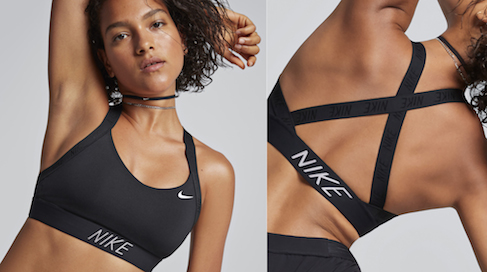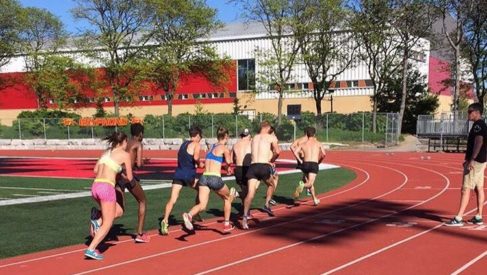By Karen Kwan
If you’re in Toronto, don’t miss out on checking out the Nike Women BraHaus Yorkdale, a pop-up shop open until this Sunday, July 30th! We got a chance to check it out before it officially opened and there’s loads in store to help support your sport.
How Eva Redpath styles her workout outfits
First, the sport bras. Book a bra fitting and while at the BraHaus you’ll get to check out a wide range of bras Nike has in their collection. Master Trainer Eva Redpath always gets dressed for her workouts starting with her sport bra and trainers, since those are key elements that are determined by what your workout is that day. For days she’s training people, she tends to stick to the light to medium support range of bras, and on days when she’s doing her own personal training, ie. days her workouts are more intense, she gravitates from the medium to the high support range of bras.
From there, she builds the rest of her outfit based on the details and colours of the bra and shoes, for example, coordinating a bra that has a cute logo on the back with a top that just perfectly shows off this detail. And while she admits she tends to gravitates towards monochromatic outfits, the new bras in Crimson are really speaking to her.
Nike Women’s three new bras
As for what’s new in the Nike Bra collection? There are three key new looks. There’s the Nike Indy Logo Bra, which offers lightweight support and wide straps, and a beautiful criss cross of straps on the back. Then, there’s the medium-impact Nike Zip Bra, which features interior molded cups combined with a compression overlay to provide support via encapsulation and compression. There’s a hidden clasp that you hook first, which makes it easier to zip up the bra. I haven’t tested this style out yet, but the idea of unzipping a sport bra in the front sounds like a much easier task than wrestling your sweaty body out of one after a long, hot run.

And thirdly, there’s the Alpha Bra, which has molded cups that provide support and an encapsulated fit, which gives great shape. This high-impact bra is great for women who have a bigger chest as there are stabilizers to help minimize bounce, and the hook and eye closure means you can make adjustments. In addition, this style’s sizing incorporates cup sizing, too.
Bra shopping tip: While there are suggested sports for each impact level, these aren’t hard-set rules, but just a guideline to help you explore and find the right bra for you. A low impact bra will have a different level of elasticity in terms of the materials it’s made of, but for a woman with a smaller chest, if she’s comfortable in that bra and feels that “the girls” are supported, she can go and wear that bra for her higher impact sports, such as running, but also for her lower impact sports such as yoga. By all means, do some jumps, squats, sun salutations–whatever movements you plan on doing in the bra during your fitting to make sure there’s nothing distracting or uncomfortable about the bra. (And speaking of yoga, the NTC app has just been updated with more yoga workouts!).
Besides the bra collection, the BraHaus is worth a visit as there is a braid bar, a matcha beverage bar (cheers!), and you can get your polaroid photo taken and then snap a shot of it with the cute little props at the flatlay station. Oh, and if you make a purchase, there’s a gift of a mix of Nike bands to style your outfits with.
Happy shopping! Post your pics from the BraHaus with #NikeWomen and #irunnation as we’d love to check out your experience there.
Karen Kwan is a regular iRun fashion and travel contributor, and you’ll find her running fashion posts every Friday on Instagram. She contributes to a number of publications and you can also follow her travel and running adventures at Health & Swellness.














 Our Magazine
Our Magazine
